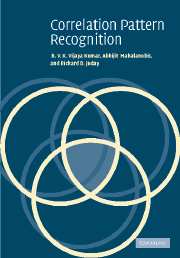Book contents
2 - Mathematical background
Published online by Cambridge University Press: 06 August 2009
Summary
Correlation filter theory relies heavily on concepts and tools from the fields of linear algebra and probability theory. Matrices and vectors provide succinct ways of expressing operations on discrete (i.e., pixelated) images, manipulating multiple variables and optimizing criteria that depend on multiple parameters. A vector representation also facilitates parallel operations on a set of constants or variables. Thus linear algebra provides powerful tools for digitally synthesizing and analyzing correlation filters.
If the world of interest contained only deterministic (i.e., non-random) signals and images, there would be no need for advanced pattern recognition methods in general and for correlation techniques in particular. In practice, reference images suffer from unpredictable disturbances such as noise, occlusion, illumination changes, rotation, and scale changes. Such unpredictability leads to randomness that can be characterized only by probabilistic models. We also need to understand what happens to such input randomness as it passes through signal processing systems such as correlation filters. Such knowledge will enable us to analyze the response of signal/image processing systems to noisy inputs, and to design systems that will preserve or enhance the desired signals while suppressing unwanted noise. This chapter aims to provide a quick review of the basics of matrix/vector techniques as well as the basics of probability theory and RVs.
While a comprehensive coverage of these fields is beyond the scope of this book, some topics relevant to correlation methods are discussed here for ease of reference.
- Type
- Chapter
- Information
- Correlation Pattern Recognition , pp. 13 - 47Publisher: Cambridge University PressPrint publication year: 2005



